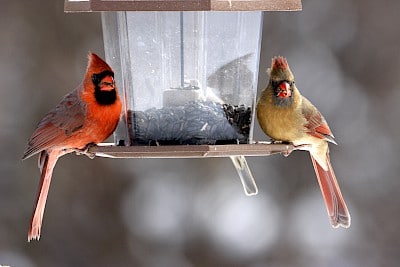Easy Bird Projects for Winter
3 easy projects to keep birds fed, hydrated, and protected this winter
The short days, frigid nights, lack of food sources, and frozen water make winter tough on the birds in your yard and garden. According to Westlake Ace Hardware, caring for our feathered friends during the coldest time of year is easy and can be accomplished with three, easy-to-do projects.
A Wintertime “Bird Buffet”
Providing reliable sources of high-calorie and high-fat foods is essential to helping wild birds survive the winter. To accomplish this, set up two separate feeding stations: one for seed and the other for suet. This will ensure you accommodate the widest array of bird species possible.
- A tube feeder—such as the Perky Pet® Squirrel-B-Gone III Bird Feeder—is an ideal choice for birdseed. Easy to fill and clean, the design on these types of feeders also helps prevent squirrels from eating the feed. Mount it either from a hook under the eve of your house or garage, or from a sturdy line secured to a tree limb.Fill your tube feeder with This high-calorie seed is ideal for all types of birds, particularly cardinals.
- High-fat suet is a wonderful food option to offer birds during the winter months. Made from a combination of nutrient-rich animal fats and seeds, it helps replace scarce insects and provides a high-calorie treat. Heath® Double Suet Cake Feeder can be easily and quickly installed near your seed feeder to provide a wide food selection.

The Never-Freeze Hydration Station
During winter, dehydration is oftentimes a bigger threat to birds than starvation. Because most natural water sources are often frozen solid this time of year, think about creating a hydration station near your bird feeders this winter.
- The easiest and least expensive way to provide access to unfrozen water is to install a waterproof heating element to an existing all-weather birdbath. The heating element will keep the water above freezing, even during the coldest months. Installation is easy and can be accomplished by running an electrical source (e.g. weatherproof extension cord) to the birdbath and securing it around the base with zip ties, which will help prevent it from becoming unplugged.
- If you don’t have a birdbath, one can be constructed easily by mounting a shallow plastic bowl atop an all-weather planter that has been filled with sand (to provide stability). If desired, you can secure the bowl to the top of he container with sealant, glue or a removable adhesive.
A Roof for Roosting
Birds have many natural defenses to help them guard against the cold, mainly the ability to fluff up their feathers. However, on frigid nights and during storms, most birds look for a warm and protected place to hunker down and roost.
- Add a few birdhouses to your garden provide protection against cold and wind. Easy to install, mount the houses at least five feet off the ground on tree trunks, wooden fence posts or under the eves of a garage or shed. Take care to locate them away from prevailing winds and feeding areas.
- If the birdhouses contain old nests from the previous season, empty them and add a fresh layer of sawdust, grass clippings or straw for extra insulation.
